Astronomical observatories offer a portal to the night skies which have intrigued humans for millennia. They are the sites of important scientific discoveries, and many are architectural gems, with locations high on mountaintops that amplify their sense of wonder. Check out eight remarkable observatories that shed a fascinating light on the galaxies above us.
Sphinx Observatory – Switzerland
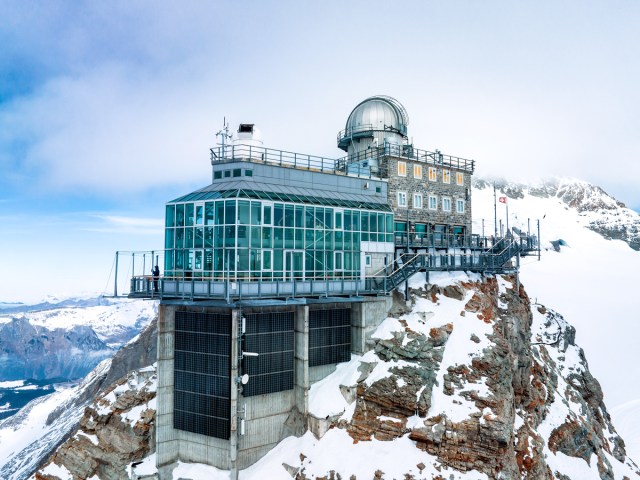
This sky-high observatory built on top of a precipitous cliff isn’t called the “Top of Europe” for nothing. Located 11,332 feet above sea level, the Sphinx Observatory is accessible via Jungfraujoch station in Switzerland’s Bernese Alps. When the station opened in 1912, it became the highest train station in Europe — at the time, access to such a high-altitude environment was unprecedented, and Jungfraujoch opened the door to scientists and researchers.
The Sphinx Observatory followed in 1937, becoming the highest building in Europe. It houses laboratories, astronomical and meteorological domes, a weather observation station, and a massive telescope — and over the decades has hosted researchers in glaciology, medicine, astronomy, and cosmic ray physics.
If you’re wondering, yes, even regular folks can check out this special spot. Not only does it offer panoramic views of the Alps, but the journey to the Sphinx Observatory — on the historic Jungfrau railroad — is also a once-in-a-lifetime experience. The tracks are built right into the mountains, and certain spots offer passengers a chance to look through windows built into the rock at various ice sculptures carved directly into the glacier.
Royal Observatory Greenwich – London, England
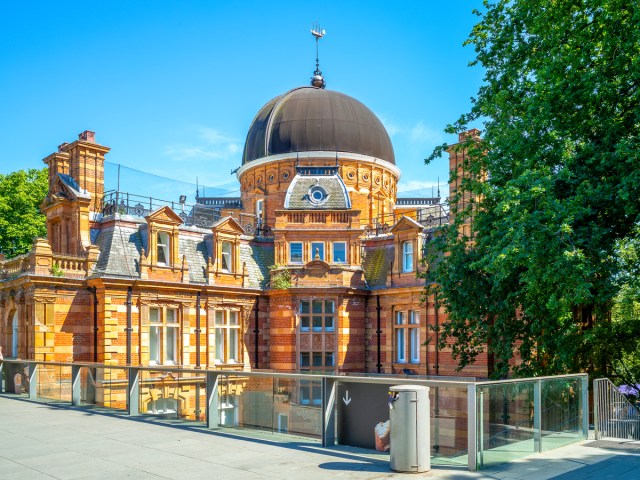
Located on a hill overlooking the Thames River in southeast London, this historic home of British astronomy and science was established by King Charles II in the 17th century. By observing the transit times of stars through the institution’s Airy telescope, astronomers at the observatory were able to create Greenwich Mean Time (GMT) as a way to standardize the world’s clocks.
In 1884, the geographical reference line running north-south across the observatory’s cobbled courtyard was established as the prime meridian, signifying zero degrees longitude (0° 0′ 0″). Every other location on Earth is measured in relation to this spot.
Today’s visitors can straddle the meridian, allowing them to simultaneously stand in both the Eastern and Western hemispheres, as well as observe the heavens through the U.K.’s largest telescope. The observatory is part of the Maritime Greenwich UNESCO World Heritage Site, which contains the historic clipper ship Cutty Sark, the Palladian-style Queen’s House, the lush Royal Park, and the Maritime Museum.
Griffith Observatory – Los Angeles, California
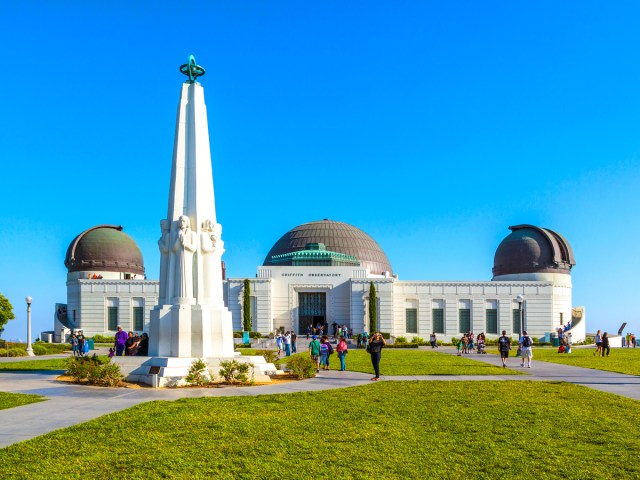
Sitting on the south-facing side of Mount Hollywood is a venerable Los Angeles institution — the Griffith Observatory. Named after Griffith J. Griffith, the observatory’s benefactor, admission to the observatory has been free since it opened in 1935 in accordance with Mr. Griffith’s will.
Inside the observatory, visitors can view space through the Zeiss refracting telescope, interact with a Tesla coil, or watch one of the eight to ten daily planetarium shows. Besides just being a hub for science education, the Griffith Observatory has made its mark as a symbol of Los Angeles through its inclusion in many films. From 1955’s Rebel Without a Cause to more recent movies like 2016’s La La Land, Hollywood has often looked nearby for a Los Angeles landmark to use on the screen.
Teide Observatory – Canary Islands, Spain
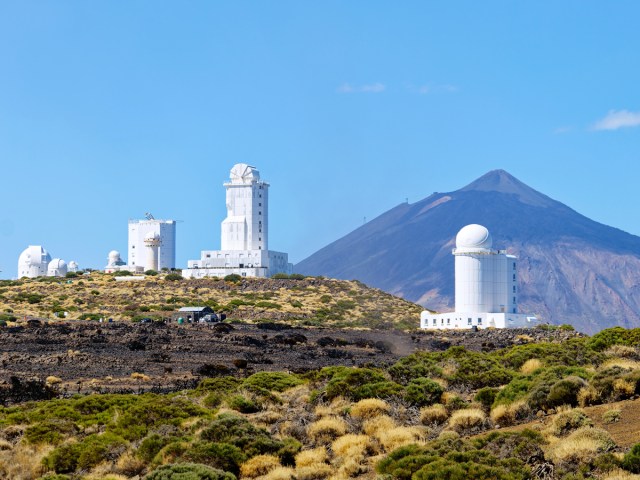
As Spain’s highest peak, Mount Teide rises almost 12,200 feet from the heart of Tenerife in the Canary Islands (a Spanish territory). The surrounding national park, a UNESCO World Heritage Site, blends volcanic boulders with petrified lava rivers, steaming vents, and gaping craters, among other surreal elements.
The park is also famous for its starry skies, and it is home to the Teide Observatory, the largest solar observatory on Earth. Located at 7,840 feet above sea level, the observatory opened in 1964 and was the site of several important astronomical discoveries, including the first black hole in the halo of the Milky Way galaxy. A range of guided tours are available to visitors.
University of Tokyo Atacama Observatory – Chile
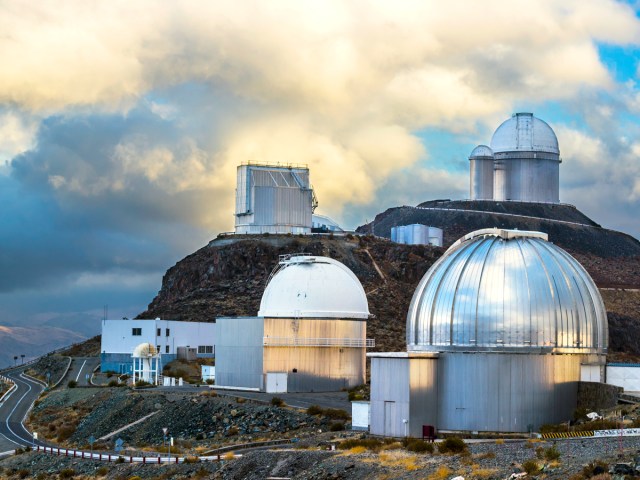
Head to the Atacama Desert in northern Chile, one of the driest places on Earth, to find the world’s highest altitude permanent astronomical observatory. The University of Tokyo Atacama Observatory lies within a lava dome at 18,503 feet on the mountain peak of Cerro Chajnantor. It houses the miniTAO, an infrared telescope that takes advantage of the observatory’s extreme altitude and thin atmosphere to allow water vapor to absorb infrared light.
Haleakalā Observatory – Maui, Hawaii

Located on the Hawaiian island of Maui, the Daniel K. Inouye Solar Telescope (DKIST) at the Haleakalā Observatory is the world’s largest solar telescope. Measuring more than 13 feet wide, the powerful telescope is able to capture the highest resolution images of the sun taken to date.
Scientists hope the telescope will help them understand some of the sun’s ongoing mysteries, such as why the sun’s outer layer, the corona, is hotter than its surface. Construction of the telescope began in 2012, and it captured its first images of the sun in December 2019.
Fabra Observatory – Barcelona, Spain

A fixture of the Barcelona skyline since 1904, the Fabra Observatory is the world’s fourth-oldest astronomical observatory still in use. Designed by architect Josep Domènech i Estapà in the Art Nouveau style, the observatory sits atop Tibidabo, a hill overlooking Spain’s second-biggest city.
The observatory is named after industrialist Camil Fabra i Fontanills, an industrialist and former mayor of Barcelona who initiated the project, which is part of the Royal Academy of Sciences and Arts of Barcelona. Today, visitors can embark on guided tours and see one of Europe’s oldest and largest telescopes, which famously discovered the comet 32P/Comas Solà in 1926.
McDonald Observatory – Texas
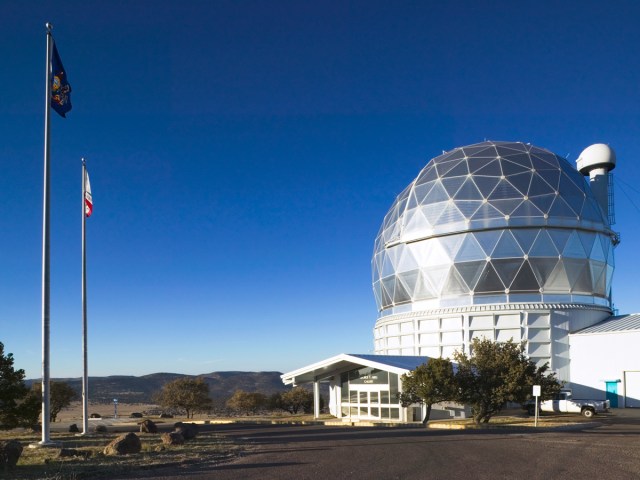
There are few better places to build an observatory than the Greater Big Bend International Dark Sky Reserve in West Texas and Northern Mexico. With an area of more than 15,000 square miles, the reserve is the world’s largest International Dark Sky Place, as recognized by the International Dark-Sky Association.
The McDonald Observatory was officially dedicated in 1939, and today, its 75,000 annual visitors can gaze at the stars in some of the darkest skies in North America. It is also a state-of-the-art hub for astronomical research, having hosted one of the world’s first lunar ranging stations, measuring the distance between the Earth and the moon.
More from our network
Daily Passport is part of Inbox Studio, which publishes content that uplifts, informs, and inspires.























